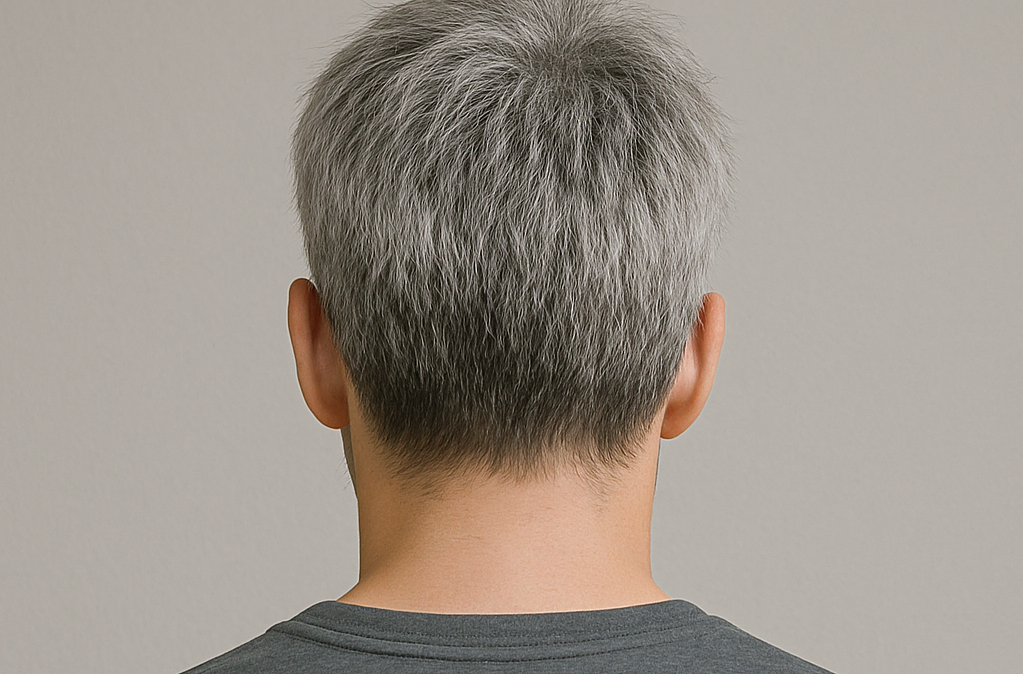Dr. Tra Anh Duy of Men’s Health, reports that many men in their 30s notice gray hairs appearing at their temples or crown, often coinciding with symptoms like decreased libido, erectile dysfunction, and premature ejaculation. This leads some to wonder if low testosterone causes premature graying.
A 34-year-old office worker consulted Dr. Duy due to low libido, premature ejaculation, and graying temples. Tests revealed low total testosterone (10.8 nmol/L) and slightly low vitamin B12. After 3 months of improved sleep, exercise, and micronutrient supplementation, his testosterone increased, graying slowed, and sexual function improved.
A 41-year-old businessman complained of fatigue, insomnia, low libido, and gray hair throughout his head. Tests showed low free testosterone, high morning cortisol, and zinc and iron deficiencies. Nutritional adjustments, relaxation techniques, and hormone therapy helped restore his sexual function and stabilize the rate of graying.
According to Dr. Duy, the question of whether low testosterone causes premature graying requires examining the role of male sex hormones, oxidative stress, and lifestyle factors affecting both sexual function and hair health.
The physiology of premature graying
Premature graying occurs when melanin-producing cells in hair follicles stop producing melanin, the pigment responsible for hair color. Oxidative stress, an excess of free radicals that damage cellular components, is a key mechanism. Oxidative stress in hair follicles can cause cell death in melanocytes, leading to hair losing its pigment and turning gray, even before old age.
 |
Illustration: AI |
The role of testosterone
Testosterone, the primary male sex hormone, influences sexual function, mood, muscle mass, and hair growth. When testosterone levels decrease, often due to age, stress, or endocrine disorders, cell regeneration and the function of androgen-dependent glands, including hair follicles, are affected.
Research by Trueb in the International Journal of Trichology shows that testosterone and its derivative, dihydrotestosterone (DHT), regulate the hair growth cycle. Testosterone deficiency can impair hair follicle activity, leading to thinning, weakened color, and increased graying.
The link between low testosterone and premature graying
Low testosterone isn't just a sexual dysfunction; it's often linked to decreased testosterone, chronic stress, and sleep disorders, all of which promote oxidative stress and hair pigmentation disorders. One study found a higher rate of sexual dysfunction in men under 40 with premature graying compared to a control group. This suggests an indirect biological link between these seemingly unrelated conditions.
Additionally, stress-induced dysfunction of the hypothalamic-pituitary-gonadal axis also affects testosterone production, contributing to both low testosterone and pigmentation disorders.
Are gray hair and low testosterone signs of biological aging?
Recent research considers gray hair and low testosterone as signs of premature biological aging. A study by Armand in Ageing Research Reviews suggests that the simultaneous decline in hormones, memory, sleep, and hair pigmentation may indicate accelerated aging in some men.
The impact of modern lifestyles
Smoking, late nights, prolonged stress, lack of exercise, and poor nutrition are common among urban men. These factors not only decrease testosterone but also promote free radical production, leading to premature aging and graying. Smokers are 2.5 times more likely to experience premature graying than non-smokers. Smoking is also linked to erectile dysfunction and reduced sperm quality.
Prevention and early intervention through lifestyle and dietary adjustments
Preventing premature graying and low testosterone requires sustainable lifestyle changes. Men should exercise regularly, prioritizing resistance training combined with light cardio to increase blood flow, improve metabolism, and stimulate testosterone production.
Adequate sleep (7-8 hours per night) is crucial for regulating hormones and reducing oxidative stress. Chronic sleep deprivation disrupts the physiological nighttime release of testosterone, leading to lower levels in the morning and affecting sexual function.
A balanced diet rich in zinc (oysters, pumpkin seeds, red meat), copper (liver, mushrooms), vitamin B12 (eggs, milk), and antioxidants (blueberries, pomegranates, green tea) protects melanin cells from free radical damage. Certain herbal extracts can also regulate the HPG axis, supporting sexual health and reducing signs of aging in men.
According to Dr. Duy, while there's no definitive proof that low testosterone directly causes gray hair, the biological link between testosterone, stress, and pigment cell activity is evident. Men shouldn't ignore premature graying accompanied by declining sexual function. Early consultation can identify the cause, enabling timely intervention to preserve both health and vitality.
Hormone and micronutrient testing plays a crucial role in determining the underlying cause. Total and free testosterone levels should be measured to assess gonadal function. LH and FSH levels help determine the activity of the hypothalamic-pituitary-gonadal axis.
Morning cortisol reflects stress levels. Assessing vitamin B12, folic acid, iron, ferritin, zinc, and copper is essential, as these micronutrients are involved in melanin production and hormone synthesis. Thyroid disorders can also cause premature graying, so TSH and FT4 levels should be checked.
Le Phuong












